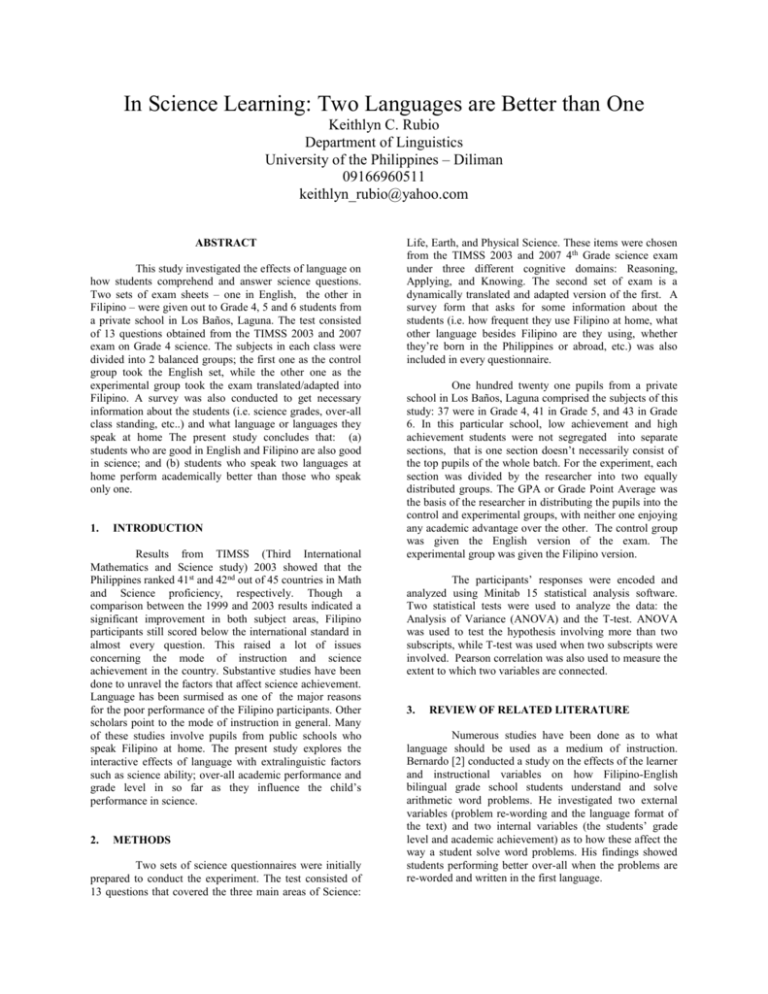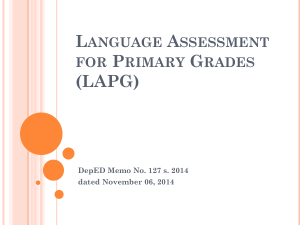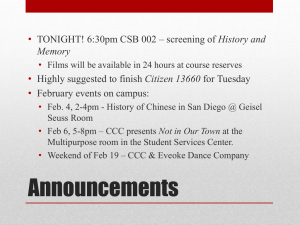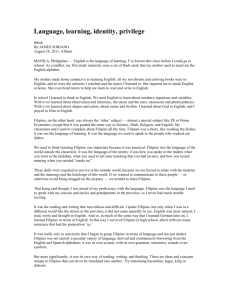In Science Learning: Two Languages are Better than One–Keithlyn
advertisement

In Science Learning: Two Languages are Better than One Keithlyn C. Rubio Department of Linguistics University of the Philippines – Diliman 09166960511 keithlyn_rubio@yahoo.com ABSTRACT This study investigated the effects of language on how students comprehend and answer science questions. Two sets of exam sheets – one in English, the other in Filipino – were given out to Grade 4, 5 and 6 students from a private school in Los Baños, Laguna. The test consisted of 13 questions obtained from the TIMSS 2003 and 2007 exam on Grade 4 science. The subjects in each class were divided into 2 balanced groups; the first one as the control group took the English set, while the other one as the experimental group took the exam translated/adapted into Filipino. A survey was also conducted to get necessary information about the students (i.e. science grades, over-all class standing, etc..) and what language or languages they speak at home The present study concludes that: (a) students who are good in English and Filipino are also good in science; and (b) students who speak two languages at home perform academically better than those who speak only one. 1. INTRODUCTION Results from TIMSS (Third International Mathematics and Science study) 2003 showed that the Philippines ranked 41st and 42nd out of 45 countries in Math and Science proficiency, respectively. Though a comparison between the 1999 and 2003 results indicated a significant improvement in both subject areas, Filipino participants still scored below the international standard in almost every question. This raised a lot of issues concerning the mode of instruction and science achievement in the country. Substantive studies have been done to unravel the factors that affect science achievement. Language has been surmised as one of the major reasons for the poor performance of the Filipino participants. Other scholars point to the mode of instruction in general. Many of these studies involve pupils from public schools who speak Filipino at home. The present study explores the interactive effects of language with extralinguistic factors such as science ability; over-all academic performance and grade level in so far as they influence the child’s performance in science. 2. METHODS Two sets of science questionnaires were initially prepared to conduct the experiment. The test consisted of 13 questions that covered the three main areas of Science: Life, Earth, and Physical Science. These items were chosen from the TIMSS 2003 and 2007 4th Grade science exam under three different cognitive domains: Reasoning, Applying, and Knowing. The second set of exam is a dynamically translated and adapted version of the first. A survey form that asks for some information about the students (i.e. how frequent they use Filipino at home, what other language besides Filipino are they using, whether they’re born in the Philippines or abroad, etc.) was also included in every questionnaire. One hundred twenty one pupils from a private school in Los Baños, Laguna comprised the subjects of this study: 37 were in Grade 4, 41 in Grade 5, and 43 in Grade 6. In this particular school, low achievement and high achievement students were not segregated into separate sections, that is one section doesn’t necessarily consist of the top pupils of the whole batch. For the experiment, each section was divided by the researcher into two equally distributed groups. The GPA or Grade Point Average was the basis of the researcher in distributing the pupils into the control and experimental groups, with neither one enjoying any academic advantage over the other. The control group was given the English version of the exam. The experimental group was given the Filipino version. The participants’ responses were encoded and analyzed using Minitab 15 statistical analysis software. Two statistical tests were used to analyze the data: the Analysis of Variance (ANOVA) and the T-test. ANOVA was used to test the hypothesis involving more than two subscripts, while T-test was used when two subscripts were involved. Pearson correlation was also used to measure the extent to which two variables are connected. 3. REVIEW OF RELATED LITERATURE Numerous studies have been done as to what language should be used as a medium of instruction. Bernardo [2] conducted a study on the effects of the learner and instructional variables on how Filipino-English bilingual grade school students understand and solve arithmetic word problems. He investigated two external variables (problem re-wording and the language format of the text) and two internal variables (the students’ grade level and academic achievement) as to how these affect the way a student solve word problems. His findings showed students performing better over-all when the problems are re-worded and written in the first language. In a later study, Bernardo [3] determined whether the language of a word problem would have an impact on how Filipino-English bilingual students understand and solve basic mathematical problem. The results showed that students performed worse, both in their first and second languages, in a mathematical problem presented in words than in the same problem presented in purely numerical format. This study confirmed findings from earlier research that indicated the effect of language processes on mathematical skills. In word problems, students were better able to understand and solve problems encoded in their first language. Adetula (1985) studied how schooled and unschooled Nigerian children use problem solving strategies to solve basic arithmetic like addition and subtraction. She also tackled the effects of language on problem solving techniques. Her findings showed that children initially have the capacity to add and subtract without formal instruction. The only difference that schooling makes is on the type of strategies children may use. Schooled children have been found to use indirect solving techniques as a result of formal schooling. She also concluded that children, schooled or unschooled, perform better if the problems are presented in their first language. Nillas (2002) investigated the relationship between language and mathematics achievement. Results showed that students who took the English version test outperformed those who took the Filipino version of the test in all content areas (fractions/numbers, measurement, data presentation, geometry, and algebra). She noted that this happened because Filipino students generally learned mathematics in their second language, English. Howie (2002) examined the performance of the South African pupils in TIMSS. She investigated on the relationship between mathematics achievement and the pupil’s proficiency in English, as well as other variables. She attributed the poor performance of South African students in the TIMSS 2003 exam to the language of instruction and the variation of the mother tongue of the teachers and students. 4. RESULTS Thirteen questions comprised the exam – all of which were obtained from the TIMSS 2003 and 2007 exam. The scoring system was also derived from TIMSS: each question is worth one point except for the third question, which was a constructed-response question, worth two points. The test items covered three cognitive domains (reasoning, applying and knowing) and three content domains (physical science, life science, and earth science). Table 1 shows the performance of the students in the three content domains. Grade Level Grade 4 Mode English Filipino Sample Size 18 19 Physical Science 13 14 Life Science 12 14 Earth Science 9 8 Grade English 5 Filipino Grade English 6 Filipino Total 20 21 22 21 121 15 13 17 15 87 16 17 20 18 97 11 9 15 13 65 Table 1. Performance of the samples in three different content domains Looking at the scores per question, it is evident that student performance varied according to topic. The table above shows that more students, an average of 97 out of 121, answered the questions correctly in the Life Science questions while a mere half of the total sample got the Earth Science questions correctly. Differences in performance per topic may be associated with learning factors, such as their science curricula. The over-all scores of the pupils to the given exam suggest that they perform well in the English or in the Filipino tests. The mean score was 9.612 out of 14 points, with the students scoring 9.967 in the English test and 9.292 in the Filipino test. Below is a table showing how well the pupils performed on a per grade level and per language basis. Grade 4 8.95 Grade 4 9.25 English = 9.967 Grade 5 9.95 Filipino = 9.292 Grade 5 8.42 Grade 6 10.82 Grade 6 10.16 Table 2. Mean score per grade level and mode. Over-all mean (121) = 9.612 As can be seen above, there is a weak but significant difference between those who took the exam in English and those who took them in Filipino. Those who answered the English version performed better than those who took the Filipino version. It is also evident that for the English test takers, pupils in the higher level scored higher than the lower levels. This didn’t hold true for pupils who were tested in Filipino version where the Grade 4 pupils scored higher than those in Grade 5. There may have been other contextual factors at work which may explain this inconsistency. Two of these may be the competency of the instructors teaching science and the curriculum itself. Another critical variable investigated in the present study was that of the class standing of the pupils – over-all and on a per subject basis. Their last quarter grades in three subjects on their report cards correlated positively with the outcome of their performance in the experiment. Pearson correlation Scores P-Value Science Grade 0.531 0.000 English Grade 0.541 0.000 Filipino Grade 0.404 0.000 Table 3. Correlation of total scores and class standing With a P-value of 0.000 in these subject areas, the correlation between each of their grades in the three subjects and their scores in the experiment were found to be highly significant. It was first assumed that the variable to which the score will be of highest correlation is the science grade. It was a pleasant surprise to discover that those who scored best in the experiment were students who were not only good in science but were also good in English AND Filipino. Mayari, et al [4] in their paper entitled “Mathtalino sa Unang Wika, e sa Ibang Wika?” conducted a similar study on the mathematical abilities of public school pupils with language as the independent variable. Their findings coincide with those of previous studies wherein Filipino-English bilingual students performed better when the exam was written in their first language. Contrary to the results obtained by Mayari et al [4], English test takers performed better than Filipino test takers in my study. Over-all class standing was also a factor that figured prominently in this study. For this purpose, the subjects were divided into the upper 50% and the lower 50% with the high achievers being expected to perform better than low achievers. Below is the table showing the performance of the upper 50% and the lower 50% in the tests. Grade Level Grade 4 Grade 5 Grade 6 Mode English Filipino English Filipino English Filipino No. Of Pupils 18 19 20 21 22 21 Upper 50% 10.22 10.3 11.4 9.64 11.28 11.4 Lower 50% 7.67 8.2 8.5 7.2 10.37 8.91 Mean 8.95 9.25 9.95 8.42 10.82 10.16 Table 4. Upper 50% VS. Lower 50% The initial assumption that the high achievers will perform better appears to be true in all levels. The highest disparity is seen in Grade 5 (English) with a mean score of 11.4 for the upper 50% compared to 8.5 for the lower 50%. Though variations between the English and Filipino test-takers were weak and insignificant in the upper 50%, Filipino test takers at this level performed slightly better, with the exception of the 5th graders wherein the mean score of the English test takers (11.4) is significantly higher than those who took the Filipino version (9.64). With the lower 50%, however, a great disparity is seen in the 6th grade with an average score of 10.37 for the English and 8.91 for the Filipino test takers. Of all the variables investigated, “other languages spoken at home” were seen to be of highest relevance to the results obtained. Eighty (80) out of 121 pupils (66%) speak another language aside from Filipino at home. 76 (95%) of this 80 speak English. Table 5 reveals that there is a high correlation between the performance of the pupils in the exam and the other languages they speak at home. For the purpose of this study, only English and Filipino will be analyzed. The table below summarizes the performance of the pupils in all grade levels between those who speak only Filipino at home and those who speak both English and Filipino. Languages spoken at home Grade 4 Grade 5 Grade 6 Mean 9.571 10.182 10 11.143 8.63 10.47 Filipino test takers Filipino only 9 8 Filipino and English 10.111 8.909 9.167 10.462 8.72 9.83 Over-all samples 7.769 8.733 10.1 9.545 9.615 10.815 8.71 10.15 English test takers Filipino only Filipino and English Filipino only Filipino and English 6.333 10.091 Table 5. Performance of Bilinguals versus monolinguals P-value (over-all) = .031 Students who use English and Filipino at home scored significantly higher (mean score = 10.15) than those who speak nothing but Filipino (mean score = 8.71.) For the English test takers, perhaps not surprisingly, those who speak English and Filipino at home scored higher with an average score of 10.52 versus those who speak only Filipino with the score of 8.75. This is the case in all levels as can be seen in the table (Grade 4 = 10.091 vs. 6.333, Grade 5 = 10.182 vs. 9.571, and Grade 6 = 11.143 vs. 10). This only goes to show that students that are proficient in two languages perform academically better than those who speak only one language. 5. SUMMARY AND CONCLUSIONS This study was conducted to investigate the effects of language and other variables on how students comprehend and answer science questions. Of all the variables investigated, other languages spoken at home tended to be of greatest influence to the pupils’ performance. This paper showed that (a) students who are good in English and Filipino are also good in science; and (b) students who speak two languages at home perform academically better than those who speak only one. 6. BIBLIOGRAPHY [1]Adetula, L. O. (1985). The Effects of Language and Schooling on the Solution of Simple Word Problems by Nigerian Children. A Report from the Project Using the Microcomputer to Teach Problem-Solving Skills. Program Report 85-17. Wisconsin Center for Education Research, Madison. [2] Bernardo, A. B. I. (1999). Overcoming Obstacles to Understand and Solving Word Problems in Mathematics, Educational Psychology, 19(2), 149-163. [3] Bernardo, A. B. I. (2002). Language and Mathematical Problem Solving Among Bilinguals, The Journal of Psychology, 136(3), 283-297. [4] Mayari, R. (2010). Math-alino sa Unang Wika, e sa Ibang Wika: A Language Experiment on Math Problem Solving. Diliman, Quezon City. [5] Howie, S. (2002). English Language Proficiency and Contextual Factors Influencing Mathematics Achievement of Secondary School Pupils in South Africa. [6] Martin, M. O., Mullis, I. V. S., et al. (2004). TIMSS 2003 International Science Report. [7] Nillas, L. (2002). Does Language Make a Difference: A TIMSS-R Analysis, The Mathematics Educator, 6(2), 95-112. [8] TIMSS 2003 Philippine Report [9] Minitab® 15.1.30.0.








